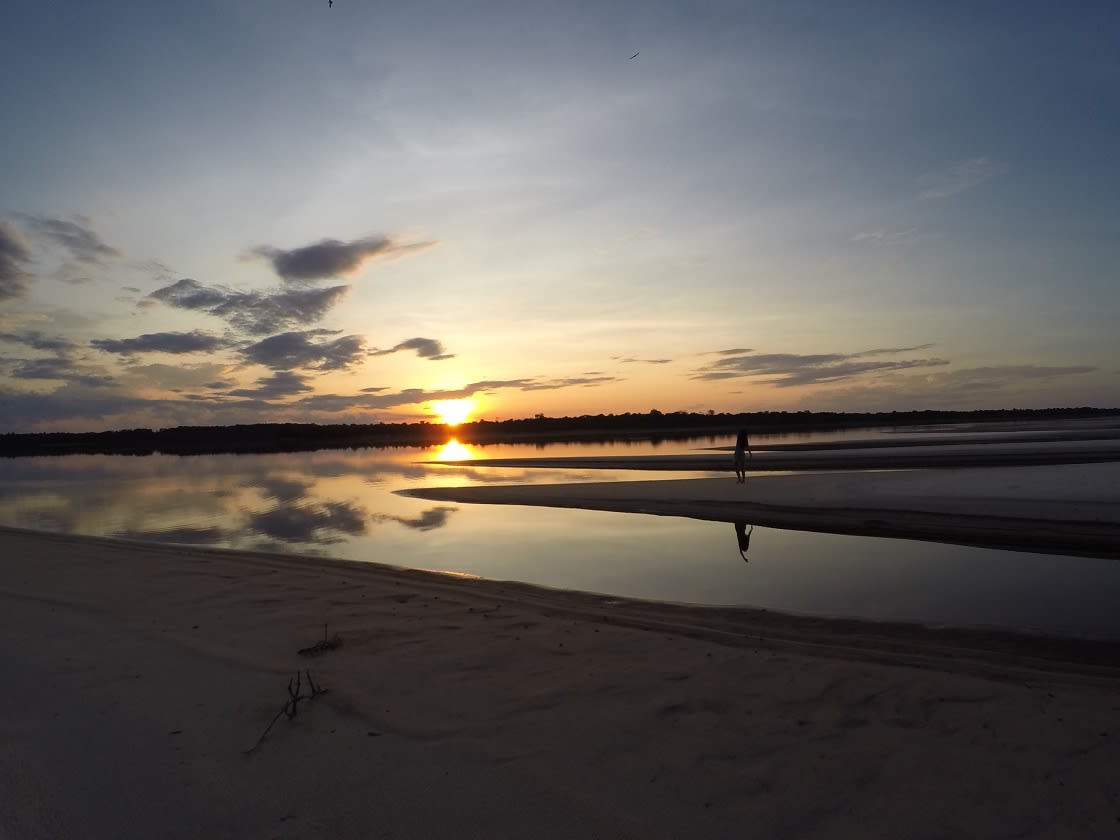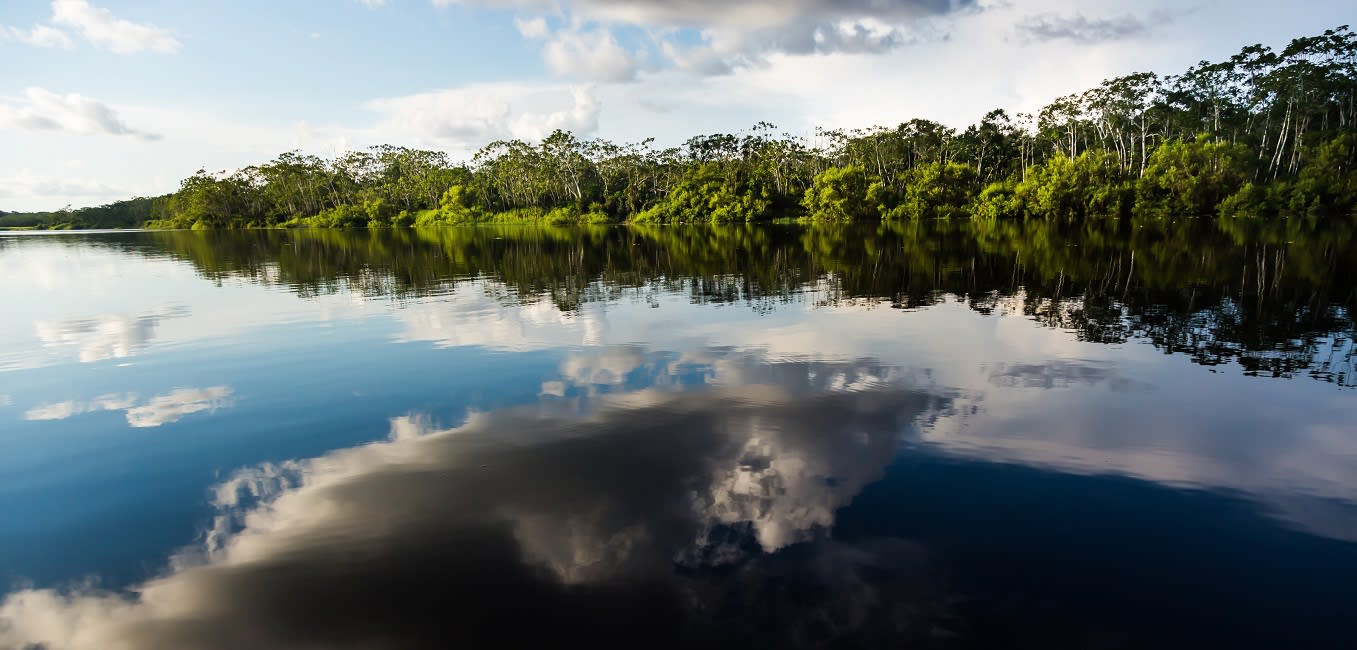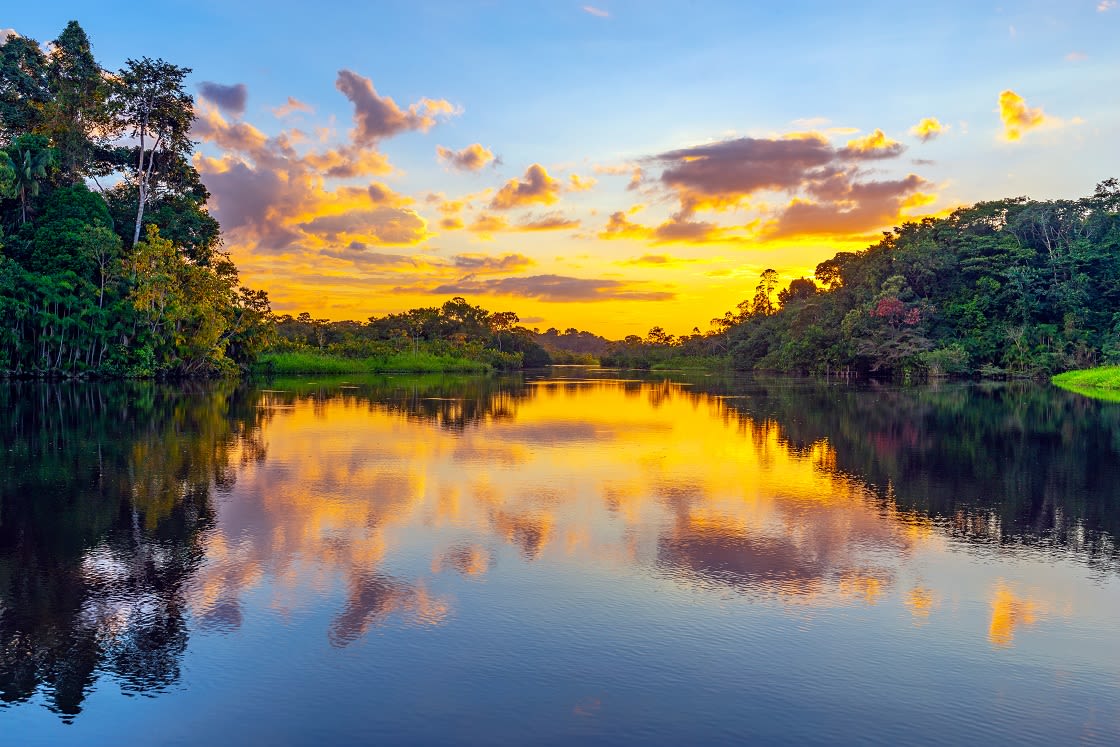
One simply runs out of superlatives describing the rainforest of the Amazon Basin (the so-called “Amazon jungle” of popular conception). About the size of the conterminous United States, this biggest river basin in the world – drained by the most voluminous (and, arguably, the longest) river on Earth – hosts the largest swath of tropical rainforest anywhere and unexcelled terrestrial biodiversity. Covering some three million square miles in total, the vast biogeographic region known as Amazonia harbors 10% or more of the world’s described lifeforms, and there’s thought to be a staggering amount of biological richness here yet uncatalogued by science.
Visiting this ecological wonder, which covers a major chunk of Brazil as well as smaller portions of Peru, Bolivia, Colombia, and Ecuador, is a legitimate pilgrimage for nature enthusiasts of all stripes. From the dizzying variety of butterflies, snakes, and frogs to such large, ultra-charismatic beasts as jaguars, harpy eagles, manatees, and pink river dolphins (or botus), sightings of animals, large and small, invariably enliven an Amazonian river cruise or guided trek. Here, in no particular order, we’ve rounded up some of the best places to visit in the Amazon jungle for spotting some of its iconic wildlife!

Jau National Park, Brazil
One of the biggest national parks in Amazonia at more than 5.6 million acres, Jau protects the entirety of the Rio Jau watershed, its borders running north to the Unini and Paunini rivers and south to the Caribinani River, and including the Jau’s confluence with the mighty Rio Negro (the blackwater river serving as one of the Amazon’s greatest tributaries). Established in 1980, Jau is now part of the UNESCO World Heritage Site of the enormous Central Amazon Conservation Complex, bigger than Switzerland and considered the world’s largest expanse of protected tropical rainforest.
Jau National Park’s mosaic of caminarana upland forest and scrub, terra firme rainforest, and extensive igapó flooded blackwater forest supports an impressive diversity of wildlife. The roster’s made up of some 120 mammal species, 455 birds, 150 reptiles, and more than 280 kinds of fish. Those who visit the park by boat (the only way to access it) can keep their eyes peeled for Amazonian manatees, pink river dolphins, giant otters, and no fewer than four species of caimans (including the great black caiman) in the flow. Bush and short-eared dogs, jaguars, giant anteaters, giant armadillos, and other terrestrial mammals reside here, while the canopy shakes and rustles with rare primates such as the white-bellied spider monkey and the golden-backed black uakari, rubbing shoulders with Amazon parrots and the kingly harpy eagle.
Jau’s about 125 miles northwest of Manaus, the main jumping-off point for river cruises to the park and host to such hotels and lodges as Juna Opera, Amazon Ecopark, and Anavilhanas Jungle Lodge.
Bordering Jau National Park and also part of the Central Amazon Conservation Complex, the Amaña Sustainable Development Reserve is a less well-known, roughly 5.8-million-acre parcel also open to river-bound exploration. Stretching between the Rio Japurá and the headwaters of the Unini and Paunini rivers, this reserve is notable for cradling one of the biggest Amazonian lakes, Lake Amanã. Terra firme forest blankets most of its acreage, though there are swaths of both várzea whitewater and igapó blackwater flooded communities.
Sharing much of the same wildlife lineup as Jau National Park, Amanã’s a good place to scan for the massive arapaima or pirarucu, one of the world’s heftiest freshwater fish, and supports perhaps the biggest population of Amazonian manatees anywhere. These gentle, whiskered hulks mass in the waters of Lake Amanã during the dry season, drifting their way during the wet season into the várzea backwaters of the adjoining Mamirauá Sustainable Development Reserve: another worthy destination within the Central Amazon Conservation Complex, and safeguarding what may be the largest expanse of whitewater flooded forest anywhere.

Manu National Park, Peru
Another huge protected area that folds into an even bigger complex of preserves, Peru’s Manu National Park an absolutely world-class ecotourism destination and definitely a shortlist contender for the best place to see Amazon wildlife. The variety here is spectacular, on account of the 1.5-million-acre park drops from the puna grasslands and cloud forests of the Andean highlands down into the steaming Amazonian rainforests far below. The ecological spectrum is vast and the biodiversity head-spinning; the fact that far-flung Manu is also so pristine takes the place into the truly sublime territory.
Need more evidence why, as a wildlife enthusiast, you should put Manu on your bucket list? Well, just consider that, in 2016, the Tropical Ecology Assessment & Monitoring Network declared this Andean-Amazonian mashup of a park the all-out global hotspot for terrestrial species diversity.
A who’s-who of Amazon Basin wildlife populates the lowlands. You’ve got as decent a chance of spotting a jaguar here as anywhere in the Amazon, not to mention its smaller relatives the puma (which essentially ranges the breadth of the park), the ocelot, and the jaguarundi. Agile tayras forage in the trees and on the ground, capybaras lounge along the waterways, South American tapirs and giant armadillos thump over the leaf litter. The aquatic food chain comes topped by the black caiman and the green anaconda. Manu’s got a rich cast of primates, which—along with the numerous three-toed sloths—do their best to stay out of the sightlines of the harpy eagle. That’s only the most formidable of more than 1,000 species of birds – yes, 1,000-plus – recorded in Manu, including a number of macaws (which congregate in brilliant spectacle at the park’s clay licks) and the striking rufescent tiger-heron.
(Manu’s extra amazing from a wildlife-spotting perspective because you can also head up into the Andes to experience a completely different montane realm, soared over by Andean condors and host to the elusive spectacled bear, South America’s only ursid, as well as Peru’s national bird, the striking Andean cock-of-the-rock.)

Clouds Reflected Over The Pucate River, In The Pacaya Samiria Reserve, Peru
It may not have the international name recognition of Manu National Park, but Pacaya-Samiria (the biggest nature reserve in Peru) is another utterly spectacular ecotourism destination in the Peruvian Amazon. It’s an extensive, seasonally inundated forest between the Mariñon and Ucayali rivers—sometimes called “the jungle of mirrors”—supports jaguars, tapirs, and monkeys, with everything from pink river dolphins, manatees, and anacondas, to sailfin catfish, anhingas (“snakebirds”), and twist-neck and yellow-spotted river turtles sliding through the riverways, lagoons, and backwaters.
Many river cruises to Pacaya-Samiria National Reserve embark from the city of Iquitos, host to such fine accommodations as Jungle House, Casa Morey, Treehouse Lodge, Victoria Regia, and the DoubleTree Hilton Iquitos.

Magic Sunset In The Yasuni National Park, Ecuador
While Brazil and Peru account for larger shares of the basin, travelers will be rewarded for investigating the somewhat lower-profile Ecuadorian Amazon as well. Certainly, Yasuni holds its own with the other Amazonian parks and preserves. Indeed, this UNESCO World Biosphere Reserve may well rival Manu National Park as the most biologically diverse spot on the planet, a special landscape close to the crossroads of the Amazon and the Andes, and near the Equator to boot.
Blanketed mainly in primary tropical rainforest, Yasuni harbors more than 600 bird species, the better part of 400 kinds of fish, and 120 or so species of reptiles, plus an almost unbelievable plethora of vascular plants. Visitors have a good shot of seeing macaws, toucans, guans, and tinamous as well as kingfishers and jacanas along the water, plus such primates as titis, pygmy marmosets, Napo sakis, red howlers, squirrel monkeys, capuchins, and the endangered white-bellied spider monkey. Jaguars and pumas rest atop the rainforest food chain in Yasuni, with peccaries, brocket deer, tapir, and capybaras among the herbivore checklist.
Seek out such strategically positioned accommodations for wildlife safaris in the Ecuadorian Amazon as the La Selva and Mashpi lodges.
Amazing as the above spots are, there are so many other productive wildlife-watching hubs in the gigantic Amazon Basin. These include the grand tropical wilderness of Brazil’s Tumucumaque Mountains National Park as well as Bolivia’s extraordinary Madidi National Park, which sweeps from high Andean mists down to the Upper Amazon rainforest and integrates with Peru’s Manu National Park in an extensive protected complex. Speaking of Peru, another celebrated Amazonian refuge is Tambopata National Reserve, perhaps best known for its density of macaw-thronged clay licks.
We’ll close by noting that, besides their wildlife credentials, any of the parks and preserves we’ve profiled here serve as some of the all-around best places to visit the Amazon rainforest in general. After all, the Amazon Basin’s chief appeal, even beyond the colorful and dramatic animals, is its sheer atmosphere: the sense and scale of its tropical wildness.
While Rainforest Cruises aim to provide accurate and up-to-date information, we make no representations as to the accuracy or completeness of any information herein or found by following any link on this site. Rainforest Cruises cannot and will not accept responsibility for any omissions or inaccuracies, or for any consequences arising therefrom, including any losses, injuries, or damages resulting from the display or use of this information.




